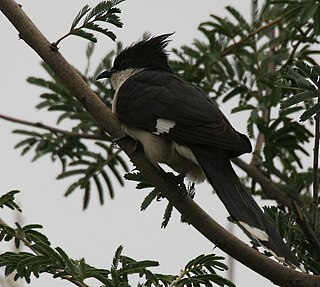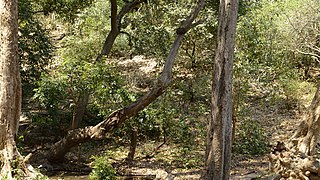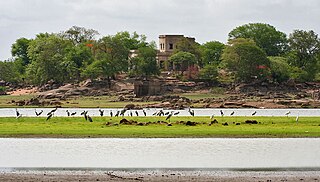
The Godavari is India's second longest river after the Ganga river and drains into the third largest basin in India, covering about 10% of India's total geographical area. Its source is in Trimbakeshwar, Nashik, Maharashtra. It flows east for 1,465 kilometres (910 mi), draining the states of Maharashtra (48.6%), Telangana (18.8%), Andhra Pradesh (4.5%), Chhattisgarh (10.9%) and Odisha (5.7%). The river ultimately empties into the Bay of Bengal through an extensive network of tributaries. Measuring up to 312,812 km2 (120,777 sq mi), it forms one of the largest river basins in the Indian subcontinent, with only the Ganga and Indus rivers having a larger drainage basin. In terms of length, catchment area and discharge, the Godavari is the largest in peninsular India, and had been dubbed as the Dakshina Ganga.

Telangana is a state in India situated on the south-central stretch of the Indian peninsula on the high Deccan Plateau. It is the eleventh-largest state and the twelfth-most populated state in India with a geographical area of 112,077 km2 (43,273 sq mi) and 35,193,978 residents as per 2011 census. On 2 June 2014, the area was separated from the northwestern part of Andhra Pradesh as the newly formed state of Telangana, with Hyderabad as its capital. Its other major cities include Warangal, Nizamabad, Khammam, Karimnagar and Ramagundam. Telangana is bordered by the states of Maharashtra to the north, Chhattisgarh to the northeast, Karnataka to the west, and Andhra Pradesh to the east and south. The terrain of Telangana consists mostly of the Deccan Plateau with dense forests covering an area of 27,292 km2 (10,538 sq mi). As of 2019, the state of Telangana is divided into 33 districts.

Gir National Park and Wildlife Sanctuary, also known as Sasan Gir, is a forest, national park, and wildlife sanctuary near Talala Gir in Gujarat, India. It is located 43 km (27 mi) north-east of Somnath, 65 km (40 mi) south-east of Junagadh and 60 km (37 mi) south-west of Amreli. It was established in 1965 in the erstwhile Nawab of Junagarh's private hunting area, with a total area of 1,410.30 km2 (544.52 sq mi), of which 258.71 km2 (99.89 sq mi) is fully protected as a national park and 1,151.59 km2 (444.63 sq mi) as wildlife sanctuary. It is part of the Khathiar-Gir dry deciduous forests ecoregion.
Shivaram Wildlife Sanctuary is a wildlife preserve in India located in Mancherial district of Telangana and is located 10 km from Manthani, 40 km from Peddapalli, 80 km from Karimnagar and 30 km from Godavarikhani. This riverine forest mixed with teak and terminalia is spread over 36.29 square kilometres (14.01 sq mi) and is home to marsh crocodiles from the river Godavari. It also harbours Indian leopards, sloth bears, nilgai, blackbucks, chitals, pythons, and langurs. The undulating natural terrain adds to the beauty of the sanctuary. It also has bird species like parrots, peacocks, harpy eagles, vultures, and the pretty macaws

Mrugavani National Park is a national park located in Hyderabad, Telangana State, India. It is situated at Chilkur in Moinabad mandal, 20 km from MGBS and covers an area of 3.6 square kilometres (1.4 sq mi) or 1211 acres. It is home to a 600 different types of plant life. The Park is home to around 350 spotted deer. The animals include: indian hare, forest cat, civet, Indian rat snake, Russell's viper, chital and the flower pecker.

The Eastern Highlands moist deciduous forests, presently known as East Deccan moist deciduous forests, is a tropical and subtropical moist broadleaf forests ecoregion in east-central India. The ecoregion covers an area of 341,100 square kilometers (131,700 sq mi), extending across portions of Andhra Pradesh, Chhattisgarh, Jharkhand, Madhya Pradesh, Maharashtra, Odisha, and Telangana states.

The Central Deccan Plateau dry deciduous forests in Western and Southern India, containing large protected areas of natural tiger habitat.
National Highway 63 is a National Highway in India, total length 860 km (530 mi). It passes through the states of Maharashtra, Telangana, Maharashtra, Chhattisgarh & Odisha.

The state of Karnataka in South India has a rich diversity of flora and fauna. It has a recorded forest area of 38720 km2 which constitutes 22.3467719% of the total geographical area of the state. These forests support 25% of the elephant population and 20% of the tiger population of India. Many regions of Karnataka are still unexplored and new species of flora and fauna are still found. The Western Ghats mountains in the western region of Karnataka are a biodiversity hotspot. Two sub-clusters of the Western Ghats, Talacauvery and Kudremukh in Karnataka, are in a tentative list of sites that could be designated as World Heritage Sites by UNESCO. The Bandipur and Nagarahole national parks which fall outside these subclusters were included in the Nilgiri biosphere reserve in 1986, a UNESCO designation. Biligiriranga Hills in Karnataka is a place where Eastern Ghats meets Western Ghats. The state bird and state animal of Karnataka are Indian roller and the Indian elephant respectively. The state tree and state flower are sandalwood and lotus respectively. Karnataka is home to 524 tigers.

Kawal Tiger Reserve is a nature preserve located at Jannaram mandal of Mancherial District in the Telangana state of India. The government of India declared Kawal Wildlife Sanctuary to be a Tiger Reserve in 2012. The reserve is the oldest sanctuary in the northern Telangana region of the state. It is well known for its abundant flora and fauna. This sanctuary is catchment for the rivers Godavari and Kadam, which flow towards the south of the sanctuary.

The Pranhita River is the largest tributary of Godavari River covering about 34% of its drainage basin conveying the combined waters of the Penganga River, the Wardha River, and the Wainganga River. By virtue of its extensive network of tributaries, the river drains a large part of Vidarbha region in Maharashtra, as well as the southern slopes of the Satpura Range in southeast Madhya Pradesh. It flows along the border of Gadchiroli district in Maharashtra and Komaram Bheem Asifabad district in Telangana. The Pranahita sub-basin is the seventh largest in India, measuring about 109,078 km2, making it larger than the individual basins of significant rivers such as the Narmada River and Kaveri.

Manjira wildlife sanctuary is a wildlife sanctuary and reservoir located in the Sangareddy district of Telangana State, India. Originally a crocodile sanctuary developed to protect the vulnerable species mugger crocodile, today it is home to more than 70 species of birds. The reservoir, located in the sanctuary, provides drinking water to Hyderabad and Secundarabad.

The Singareni Collieries Company Limited or SCCL is a government-owned-coal mining corporation in India. It is under the ownership of Department of Energy, Government of Telangana. The Union Government's administration of the company is through the 49% ownership held by Ministry of Coal. SCCL is currently operating 45 mines where 20 opencast and 25 underground mines in 6 districts of Telangana with a manpower around 45,079 as of Nov. 2020. SCCL is contributing 9.2% in the all India Domestic Production. Since inception (1889) 1.36 BT of Coal is extracted by SCCL and it has proved reserves of 10.84 BT.

Pakhal Lake is a man-made lake in the Pakhal Wildlife Sanctuary in the Warangal district of Telangana, a state in Southern India.

Kinnerasani Wildlife Sanctuary is a forest located in Bhadradri Kothagudem district, Telangana state of India. The wildlife sanctuary is spread over an area of 635.40 km2 with the picturesque Kinnerasani Lake with densely forested islands in the middle of the sanctuary. It is 15 km (9.3 mi) from the district Headquarter Kothagudem and 25 km (16 mi) from Temple Town Bhadrachalam.

Eturnagaram Wildlife Sanctuary is a wildlife sanctuary located in Eturnagaram village in Mulugu district in Telangana, India. It is located 250 km (160 mi) away from Hyderabad, it is integrated tribal development town.

Sathyamangalam Tiger Reserve is a protected area and tiger reserve in the Eastern Ghats in the Erode District of the Indian state of Tamil Nadu. It has a tiger population of 83 individuals and a leopard population of 111 individuals according to the 2019 census.

Pocharam Wildlife Sanctuary is a forest and wildlife sanctuary located 15 km (9.3 mi) from Medak and 115 km (71 mi) from Hyderabad, Telangana, India. Spanning over 130 square kilometres (50 sq mi), in the districts of Nizamabad and Medak, it was a former hunting ground of the Nizam that was declared a wildlife sanctuary in the early 20th century. It is named after the Pocharam lake, formed from the bunding of the Allair from 1916-1922. The sanctuary has an ecotourism center for visitors. It is home to many species of birds and mammals. The sanctuary is situated 100 km from Nizamabad city.
The Parvati Barrage, also known as the Sundilla Barrage is an irrigation project located at Kasipeta Village, Manthani Mandal, Peddapalli district in Telangana State, India.
The Kaleshwaram Lift Irrigation Project (KLIP) is a multi-purpose irrigation project on the Godavari River in Kaleshwaram, Bhupalpally, Telangana, India. Currently the world's largest multi-stage lift irrigation project, its farthest upstream influence is at the confluence of the Pranhita and Godavari rivers. The Pranahita River is itself a confluence of various smaller tributaries including the Wardha, Painganga, and Wainganga rivers which combine to form the seventh-largest drainage basin on the subcontinent, with an estimated annual discharge of more than 6,427,900 acre-feet (7,930 cubic hectometres) or 280 TMC. It remains untapped as its course is principally through dense forests and other ecologically sensitive zones such as wildlife sanctuaries.
















